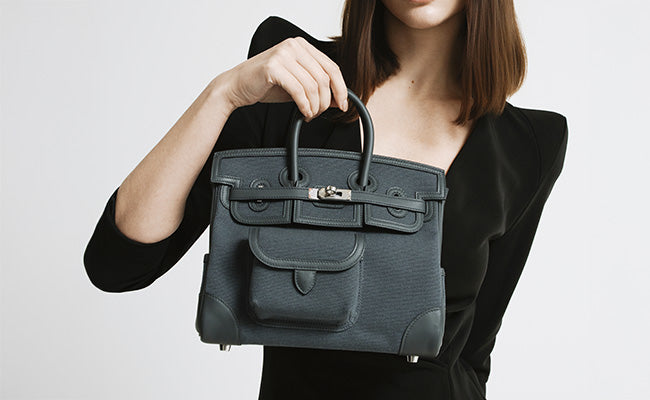
Paying Safely Online: Cards, Wires, and Trusted Checkouts Compared
Check out our Hermès collection and Birkin bags!
Online payment fraud losses could top $400 billion over the next decade. That’s a staggering number, and it’s a reminder that secure payment choices matter, especially when we’re splurging on luxury.
Whether it’s that elusive Birkin bag or a once-in-a-lifetime experience, knowing how digital payments work is the first step in protecting both our money and our sanity.
Credit cards with fraud protection and digital wallets using tokenization technology offer the strongest security for online luxury purchases, while methods like debit cards and wire transfers carry significantly higher risks.
The payment method we pick can be the difference between a seamless splurge and a nightmare that drains our accounts and patience.
From contactless payments at high-end boutiques to checkout systems for online luxury retailers, let’s dig into how different payment options really stack up.
Understanding these choices means we get to enjoy the finer things without giving cybercriminals a chance to join the party.
Key Takeaways
- Digital wallets and credit cards offer the best fraud protection thanks to encryption and tokenization
- Wire transfers and debit cards are riskier and best avoided for most online luxury purchases
- Sticking with reputable payment gateways and monitoring transactions goes a long way toward reducing fraud
Why Online Payment Security Matters
When we drop serious cash online, cybercriminals notice. Hackers hunt for personal data, identity thieves open accounts in our names, and scammers invent new tricks to separate us from our hard-earned dollars.
Risks of Online Payments
Financial exposure takes on a whole new meaning when luxury is involved. If someone nabs our card info and uses it for a $15,000 Hermès Birkin, that’s not just a headache; it’s a crisis.
Our payment data bounces through several systems every time we buy something. Card numbers, CVV codes, names, all of it travels from merchant to payment processor to bank. Each stop is a potential weak spot.
Unsecured websites are a minefield. If a site doesn’t use proper encryption, anyone snooping on the network could grab our payment info.
Public Wi-Fi only makes things worse. That airport hotspot we use to snag a limited edition? Hackers love those networks. They lurk, waiting to scoop up payment data from unsuspecting shoppers.
Third-party payment processors complicate things. They usually add security, but they also stash our info in more places, which can be a double-edged sword.
Identity Theft and Data Breaches
Data breaches at major retailers have exposed millions of customer records in recent years. When luxury retailers get hit, thieves access not just payment information but complete customer profiles including purchase histories and preferences.
Identity thieves use stolen info to open new credit accounts, and they love targeting high-income shoppers because those accounts usually have higher limits.
Synthetic identity theft is another headache. Criminals mix real information with fake details to create new identities, using these for big-ticket purchases that might not show up on our radar until it’s too late.
Our social insurance numbers, addresses, and phone numbers turn into hot commodities on the dark web. If we shop luxury, we’re even more of a target; crooks figure we have better credit and more to spend.
Online Fraud and Phishing Scams
Phishing scams aimed at luxury shoppers are getting slick. We get emails from “Chanel” or “Louis Vuitton” about exclusive sales or waitlists, and if we’re not careful, we hand over payment details to scammers.
These fraudsters build nearly perfect copies of real luxury sites. They buy domains with tiny misspellings and mimic every detail.
Business email compromise attacks are a nightmare for high-value transactions. Scammers intercept emails between us and retailers, then send fake payment instructions to reroute our money.
Social engineering plays on our excitement for exclusive drops. Fake social media accounts promise insider access, then ask for payment through sketchy channels.
The fallout isn’t just financial. We’re left cleaning up our credit, fighting to close accounts, and dealing with the stress of disputing fraudulent charges, sometimes for months.
Comparing Popular Online Payment Methods
When we’re about to drop five figures online, the right payment method can make all the difference. Credit cards bring strong fraud protection, digital wallets add both convenience and security, and bank transfers have their own niche.
Credit Cards Versus Debit Cards Online
Credit cards are the gold standard for online luxury shopping. They put a layer between us and fraudsters. If someone uses our card without permission, we’re usually on the hook for $50 max, and even that’s rare.
Debit cards, on the other hand, draw straight from our bank. If a thief gets in, our cash is gone until the bank sorts it out, which can take a while.
Why credit cards win:
- Extended warranties on purchases
- Protection if items arrive damaged
- Rewards points for travel or perks
- Chargeback rights for disputes
Debit cards might work for daily spending, but they don’t offer these perks. When it’s a high-stakes purchase, credit cards just feel safer.
Digital Wallets and Mobile Payment Apps
Apple Pay, Google Pay, and PayPal have changed the way we pay online. These apps use tokenization, swapping out our real card numbers for single-use codes.
Digital wallets add another layer with things like fingerprint or face ID. Even if someone steals our phone, they probably can’t buy anything.
What digital wallets bring to the table:
- Fast, one-click checkouts
- Encrypted payment data
- Instant transaction alerts
- Loyalty program integration
PayPal also gives us buyer protection, similar to credit cards. If something goes wrong, disputes are easy and refunds are usually quick. Lots of luxury retailers now accept these options, so we can check out with minimal fuss.
Bank Transfers, Wires, and ACH Payments
Direct bank payments can work well for big-ticket luxury buys. ACH payments move money bank-to-bank with lower fees than credit cards. Some luxury merchants even offer a discount for using bank transfers.
Wire transfers are faster but come with higher fees. Sometimes, for a rare item or private seller, a wire is the only way.
eChecks blend the old-school check with digital speed. They clear faster than paper checks and use the same ACH system.
Bank transfers are secure since they require our banking credentials, but they don’t offer chargeback protection. Once the money’s gone, it’s gone unless the seller agrees to return it.
Prepaid Cards and Gift Cards
Prepaid cards cap our risk by limiting how much can be stolen. We load a set amount, so if someone gets the card info, they can’t drain our main accounts. They’re handy for shopping at unfamiliar sites or overseas.
Gift cards from luxury retailers sometimes come with bonuses. Spend $1,000, get $1,200 in store credit? Not bad.
Why prepaid options appeal:
- Control over spending
- Protects main bank accounts
- Occasional bonuses or promos
- Great for gifts
But, prepaid cards don’t usually have the same fraud protection or rewards as credit cards. Disputing charges is tougher, so use them with retailers you trust.
Trusted Payment Gateways and Checkouts
Major payment gateways like PayPal and Stripe bring strong security features and buyer protections to luxury shopping. Virtual credit cards add another shield by creating unique numbers for each transaction.
PayPal, Stripe, and Leading Gateways
PayPal is a household name, especially when we’re spending serious money on a Birkin or Kelly. It handles payments in over 130 currencies and has solid fraud detection built in.
Stripe is popular among luxury retailers for its customizable checkout. It charges 2.9% plus $0.30 per transaction, no monthly fees, and fits right into high-end e-commerce.
Square works well for boutiques that sell both online and in-person, charging 2.65% for major credit cards. Braintree (owned by PayPal) supports digital wallets like Apple Pay and Google Pay.
What to look for:
- PCI DSS compliance for data security
- Multi-currency support for international shopping
- Mobile-friendly checkout
- Easy integration with e-commerce platforms
Buyer Protection Features
Most reputable gateways offer purchase protection, which is a relief when luxury purchases go sideways. PayPal’s Buyer Protection can cover us if items don’t arrive or aren’t as described.
Credit card payments through secure gateways let us dispute charges within 60 days. That’s a lifesaver when dealing with expensive items.
Stripe uses machine learning to spot sketchy transactions before they go through. It looks for odd patterns and flags anything suspicious.
Levels of protection:
- Refunds for non-delivery or misrepresented items
- Chargeback rights through card issuers
- Seller verification for peace of mind
- Dispute resolution if things get messy
Virtual Credit Cards for Online Shopping
Virtual credit cards create a one-time-use number for each purchase, shielding our real account info. Many banks now offer this feature right in their apps.
These numbers usually expire after one use or a set period. If a retailer gets hacked, our real card stays safe. It’s a great option for one-off luxury splurges.
Capital One, Citi, and Bank of America all have virtual card services, usually for free. We can set spending limits and even restrict which merchants can use the number.
It takes just seconds to generate a virtual card. Use it, check out, and then the number is useless for future transactions.
Advanced Security Technologies for Online Payments
Modern payment security leans on encryption, tokenization, and multi-factor authentication to keep our data safe. These layers work together, making it tough for fraudsters to break through.
Encryption and SSL
When we’re eyeing that Hermès Kelly or browsing luxury boutiques online, HTTPS and SSL certificates create an encrypted tunnel between our browser and the retailer’s server. This scrambles our card data so it’s unreadable in transit.
Point-to-point encryption (P2PE) takes it further, locking down payment data from the moment we enter it until it hits a secure destination. It’s like a briefcase that only opens at the right spot.
Most reputable luxury retailers use 256-bit SSL encryption, the same stuff banks rely on. Look for the padlock in the browser bar and make sure the URL starts with "https://".
This foundation keeps our info safe, even if someone’s snooping on the connection.
Tokenization for Extra Protection
Tokenization swaps our real card numbers for random tokens that are useless to thieves. When we save payment info on luxury sites, it’s usually a token, not the actual number.
If a retailer gets breached, hackers only get gibberish. Tokens can’t be reverse-engineered or used elsewhere.
This tech lets us enjoy one-click checkouts and subscriptions without exposing sensitive details. Many privacy tools now use tokenization by default.
We don’t see tokenization working, but it’s there, letting us check out faster and safer.
Biometric Authentication and MFA
Multi-factor authentication (MFA) adds another hurdle for would-be thieves. When we buy pricey items, we might have to enter a code, use an authenticator app, or verify with a fingerprint or face scan.
Biometric authentication relies on what makes us unique: our fingerprint, face, or even voice. Unlike passwords, these can’t be easily stolen or guessed.
Modern smartphones let us pay with a glance or a touch via Apple Pay, Google Pay, or Samsung Pay. Usually, we need both our biometric data and the device itself.
Three Domain Secure (3DS) tech sends us a code during checkout, adding another barrier for fraudsters without slowing us down too much.
Fraud Protection and Monitoring Strategies
Fraud detection systems, verification codes, and real-time alerts work together to keep our luxury purchases safe. These tools let us shop confidently, knowing someone’s watching for trouble.
Fraud Detection Systems
Modern fraud detection systems use AI to spot odd spending patterns. They learn what’s normal for us and flag anything that doesn’t fit.
For luxury buys, this is crucial. The system needs to tell the difference between our legitimate splurge and a thief’s attempt to score big.
Machine learning looks at things like:
- Where and when we’re buying
- Device fingerprints and IP addresses
- How quickly we’re spending
- Merchant types and transaction sizes
Visa and Mastercard process this info in milliseconds, scoring each transaction. If something looks risky, they might ask for more verification or block the purchase.
Banks also keep an eye on our accounts for unusual activity, helping catch fraud rings or counterfeiters before they do serious damage.
Card Verification Value (CVV) and Security Codes
The CVV code on credit cards is a small but crucial line of defense against online fraud. Those three or four digits show you actually have the card in hand when you buy something.
CVV verification works because merchants never store this code in their databases, and it doesn’t get sent along with your card swipe. Only the person holding the card knows it or at least, that’s the idea.
Different card networks have their quirks:
- Visa/Mastercard: 3-digit CVV on the back
- American Express: 4-digit code on the front
- Dynamic CVV: Codes that change on certain premium cards
If you’re shopping for luxury goods online, check that the merchant asks for your CVV. Real retailers always require it for online purchases.
Some high-end cards now use dynamic security codes that refresh every few hours. This makes stolen card numbers pretty much worthless for online thieves.
Real-Time Fraud Alerts
Real-time fraud alerts pop up when something fishy happens with your account. These instant pings can stop fraud before it spirals.
Most banks and card issuers let you pick your alert style:
- Text messages to your phone
- Emails about account activity
- Push notifications from apps
- Phone calls for big-ticket transactions
You can tweak alert thresholds to match your habits. Setting lower limits for international or unusual purchases gives you a little more peace of mind.
Fraud monitoring can freeze your card if it spots weird activity, blocking extra charges until you confirm what’s up.
Honestly, speed matters here. The quicker you flag a sketchy charge, the better your odds of getting your money back and keeping your account safe.
Exploring Anonymous and Privacy-First Options
When you’re dropping real money on luxury items online, keeping your financial life private suddenly feels a lot more important. Digital currencies promise some anonymity with blockchain tech, and VPNs help cover your tracks from snoops.
Cryptocurrency and Blockchain for Privacy
Cryptocurrencies like Bitcoin and Ethereum aren’t as private as people think. Every transaction is stamped onto a public blockchain that anyone can check out.
Your real name isn’t there, but your wallet address is: a digital fingerprint. If you’ve ever bought crypto through an exchange that asked for your ID, that wallet can be traced right back to you.
Privacy coins do a better job hiding your tracks. These coins use some clever cryptography to keep transaction details secret.
The big worry? If someone gets your private key, your whole wallet is gone in seconds. With crypto, there’s no calling the bank for a refund if you get hacked.
Most exchanges still want your personal info and government ID, so buying crypto anonymously isn’t really a thing.
Anonymous Transactions and Digital Currencies
Gift cards are still about as anonymous as it gets. Buy them with cash in-store, use them online, and you don’t have to hand over any personal details.
Prepaid debit cards are close, but with a bit more flexibility. You can load them up with cash, and they’re not tied to your name.
Drawbacks? There are usually activation fees (think $3-5 each) and limits on how much you can buy at once.
Virtual payment cards sort of split the difference between privacy and convenience. Some password managers and banks let you generate a temporary card number just for one purchase.
E-wallets like PayPal let you use a nickname instead of your real name with merchants, but PayPal itself still knows who you are.
VPN and Privacy Tools for Discreet Shopping
A decent VPN encrypts your payment data when you shop online. That makes it much harder for hackers to intercept your card info.
VPNs also hide your IP address, so retailers can’t easily track your browsing or build a profile of your shopping habits.
For luxury purchases, this extra layer of security really matters. High-value sales attract more attention, both from security systems and from crooks.
Pairing anonymous payment methods with a VPN is about as private as online shopping gets.
Some VPNs even let you access geo-locked payment options, though you’ll want to double-check you’re not breaking any rules.
Insider Tips for Safe and Rewarding Checkout Experiences
Picking the right payment method can protect your luxury buys and rack up some sweet rewards points. The trick is balancing security with perks. Why not get both if you can?
Choosing the Safest Payment Method
Credit cards are still the gold standard for luxury shopping online. They cap your liability at $50 for fraud, and most banks won’t even make you pay that.
Digital wallets like Apple Pay and Google Pay add another security layer. They use tokenization, so your real card number is never shared: just a one-time code that’s useless if stolen.
For big buys, skip debit cards. They pull straight from your bank account and don’t have the same fraud protections.
ACH payments can work with trusted luxury retailers. These are secure bank transfers with lower fees than cards.
Cash might feel safe, but if something goes wrong, you’re out of luck. When you’re spending big, you want the backup that credit cards provide.
Contactless and Tap-to-Pay Options
Contactless payments use near-field communication to create a unique code for each transaction. That makes counterfeiting nearly impossible.
Most new cards have the contactless symbol. Just tap instead of inserting: safer and faster.
Mobile wallets take it further. You have to unlock your phone (with your face or fingerprint) before you can pay.
Chip cards are still solid if you can’t tap. EMV chips generate unique codes for every purchase, making them way harder to clone than magnetic stripes.
Mastercard, Apple Pay, Google Pay, and Zelle
Apple Pay encrypts your card info and locks payments behind Touch ID or Face ID. Your card number isn’t stored on your device or shared with stores.
Google Pay does much the same, storing encrypted payment data on Google’s servers. It works on Android and with a lot of luxury retailers.
Mastercard offers strong fraud protection and zero liability. Many premium cards run on the Mastercard network, so you get extra purchase protections.
Zelle is best for sending money to people you know. Don’t use it for online shopping; it doesn’t have the fraud protections of credit cards.
Cash App and Venmo are handy for splitting bills, but not great for luxury buys. Their buyer protection is pretty limited.
Frequently Asked Questions
Payment security is a big deal when you’re shelling out for luxury goods. Credit cards, wire transfers, and checkout services all have their own quirks and protections.
What's the real deal with credit card protections for my latest shopping spree?
Credit cards offer some of the best fraud protection out there, especially for big purchases. Major banks guarantee you’ll get your money back if someone uses your card without permission.
When you use a credit card from a solid bank, you get extra layers of protection that other payment methods just don’t match. The card company steps in between you and any shady sellers.
If your Hermès bag never shows up or isn’t as promised, you can file a chargeback. That’s a lifesaver when you’re spending thousands.
How can I ensure my wire transfers are decked out with top-notch security?
Wire transfers are a one-way street: once you send the money, it’s gone. Always double-check the recipient’s info and confirm details through a separate channel.
Only wire money to established retailers you’ve researched. If someone’s pushing you to wire funds fast, walk away.
Use your bank’s secure online platform, not random third-party services. Big banks have better security, and they might be able to help if something goes wrong.
Is swiping for a new Birkin a safe bet or should I opt for those fancy new e-wallets?
Credit cards are usually safer than e-wallets for luxury stuff because of their strong fraud protections. E-wallets are convenient, but not all of them offer the same buyer coverage.
Digital wallets like Apple Pay or Google Pay are a step up from entering your card number directly: they use tokenization, so your real info stays hidden.
For high-end items, stick with payment methods that offer real buyer protection. The convenience of an e-wallet isn’t worth risking thousands if something goes sideways.
Can I trust these checkout services claiming to guard my cash like a beefeater or is that just posh talk?
Well-known checkout services like PayPal or Stripe do offer buyer protections, but always read the fine print. Their rules might not be the same as your credit card’s.
Stick to reputable payment processors: look for ones that encrypt your info and don’t keep sensitive data on file.
If a checkout service feels sketchy or you’ve never heard of it, think twice before using it for expensive items. Go with what luxury retailers already trust.
Are prepaid cards the secret to securing my bling without the credit score sting?
Prepaid cards limit your risk since you can’t lose more than what’s on the card. For unfamiliar retailers, it’s a nice way to cap your exposure.
That said, prepaid cards usually don’t have the fraud protection or chargeback options that credit cards do. You’re trading robust coverage for a spending limit.
For luxury buys, credit cards almost always offer better protection than prepaid cards. Save those for smaller, riskier purchases.
When dropping major coin online, what's the lowdown on keeping my luxe life hack-free?
Try using virtual credit card numbers for those one-off luxury splurges, especially when it's a retailer you've never dealt with. Most banks have an option for temporary card numbers: super handy for keeping your real info under wraps.
Stick to shopping on encrypted sites that show HTTPS and that little padlock in the address bar. Our payment details should get the same VIP treatment as our luxury goods, right?
Turn on multi-factor authentication for all your accounts, and actually check your credit card statements often. If we're dropping big bucks, we really ought to watch our accounts like hawks.




